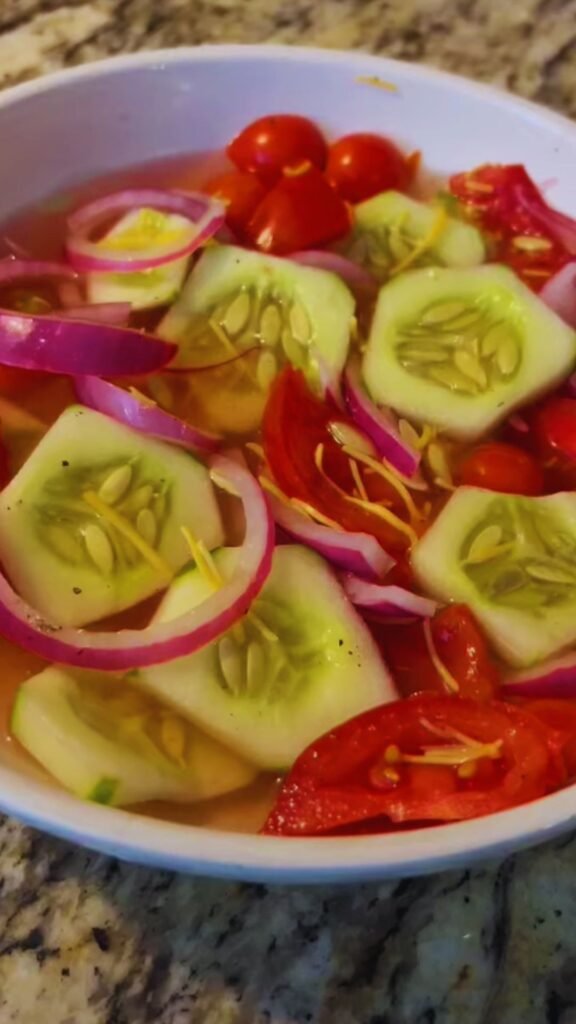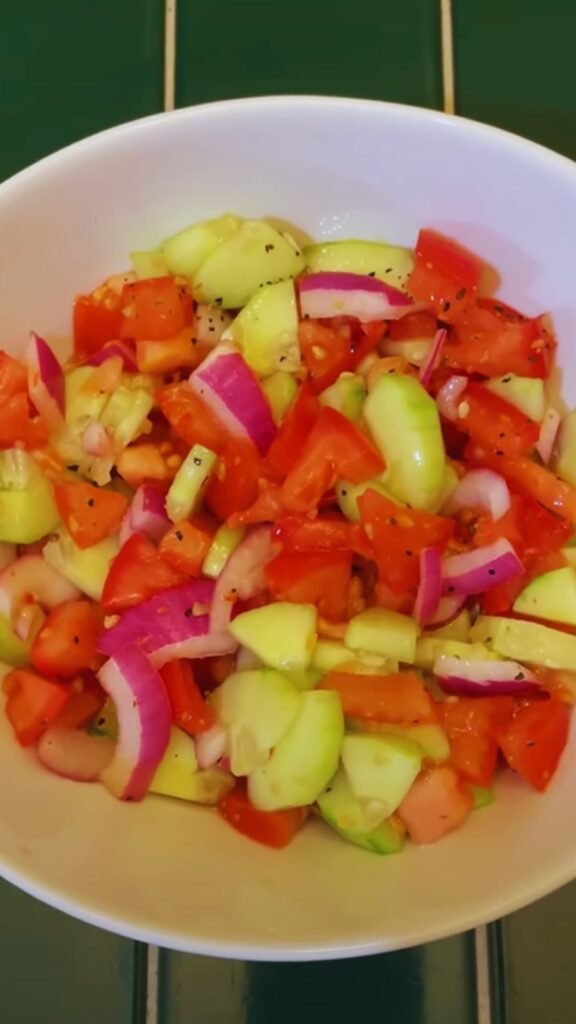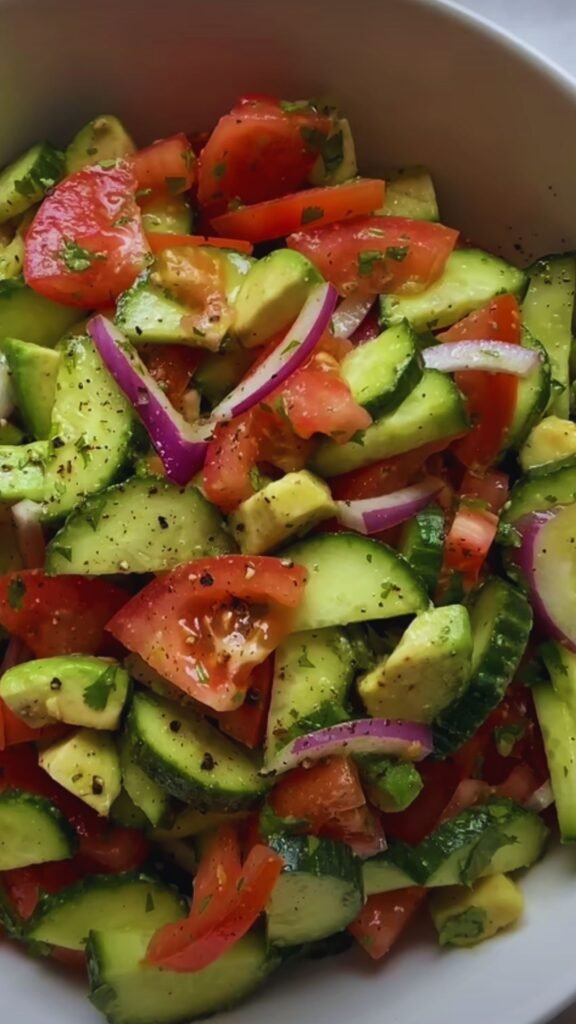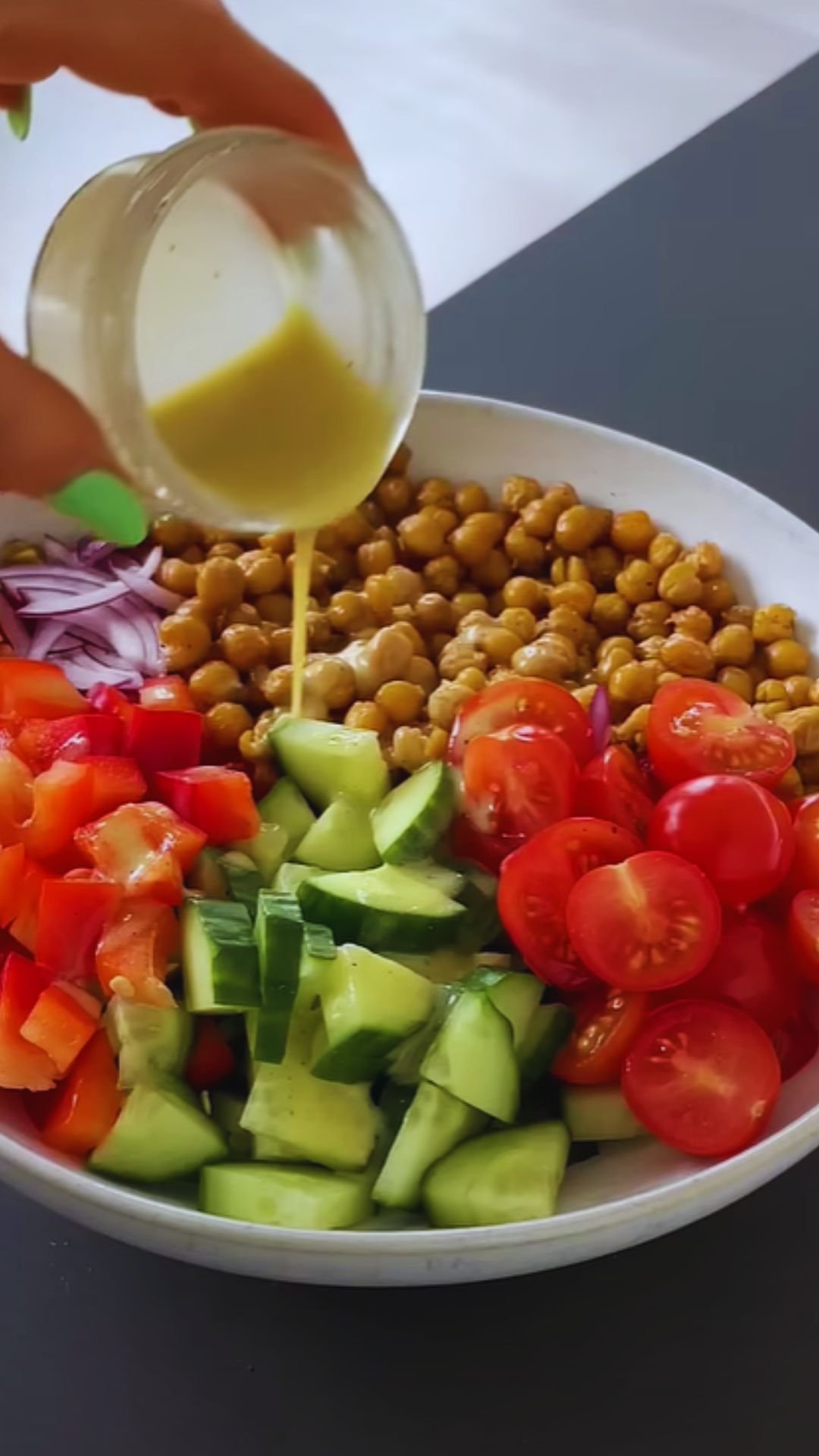There’s something magical about the combination of cool, crisp cucumbers and juicy, sun-ripened tomatoes. When summer’s bounty is at its peak, I find myself constantly returning to this simple yet spectacular salad that showcases the best seasonal produce. The addition of thinly sliced red onions brings a pleasant bite that balances the sweetness of heirloom tomatoes perfectly. This is my go-to recipe when I want to impress guests with minimal effort or simply treat myself to a refreshing lunch on a warm afternoon.
The Beauty of Simplicity
I’ve always believed that the most memorable dishes are often the simplest ones. This cucumber and heirloom tomato salad exemplifies that philosophy, allowing quality ingredients to shine without unnecessary complications. Each bite offers a different experience—from the refreshing crunch of cucumber to the sweet-tart burst of tomato juice and the pleasant sharpness of red onion.
The first time I made this salad was during a particularly hot summer when my garden was overflowing with tomatoes and cucumbers. Rather than letting them go to waste, I began experimenting with different combinations and dressings. This recipe is the culmination of years of refinement, and I’m excited to share it with you today.
Ingredients: Quality Matters
The secret to an exceptional cucumber and heirloom tomato salad lies in the quality of ingredients. Here’s what you’ll need:
- 2 large English cucumbers (or 4-5 Persian cucumbers)
- 1½ pounds of assorted heirloom tomatoes (approximately 3-4 medium tomatoes)
- 1 small red onion
- ¼ cup extra virgin olive oil (the best quality you can afford)
- 2 tablespoons red wine vinegar
- 1 tablespoon fresh lemon juice
- 2 garlic cloves, finely minced
- 2 tablespoons fresh herbs (a mix of basil, mint, and dill works wonderfully)
- 1 teaspoon honey or maple syrup (optional, to balance acidity)
- Sea salt and freshly ground black pepper, to taste
- ¼ cup crumbled feta cheese (optional)
- 2 tablespoons toasted pine nuts or walnuts (optional)
Understanding Your Ingredients
English cucumbers : Also known as hothouse or seedless cucumbers, these have thinner skin and fewer seeds than regular cucumbers. They’re less bitter and don’t require peeling, making them ideal for salads.
Heirloom tomatoes : These are open-pollinated (non-hybrid) tomato varieties that have been passed down through multiple generations. They come in various colors, shapes, and flavor profiles, adding visual appeal and complex flavors to your salad.
Red onion : These have a milder, sweeter flavor than yellow or white onions when used raw, and their vibrant purple color adds beautiful contrast to the salad.
Extra virgin olive oil : The foundation of your dressing. Look for cold-pressed, single-origin oils for the best flavor. A peppery Tuscan or fruity Spanish variety works beautifully here.
Red wine vinegar : Provides acidity and depth. You can substitute with white wine vinegar or champagne vinegar if preferred.
The Art of Preparation

Preparation is key to this salad’s success. The way you cut each ingredient affects not only the presentation but also how the flavors and textures interact on your palate.
Step-by-Step Instructions
- Prepare the cucumbers: If using English cucumbers, I typically leave the skin on for color and nutrients. For regular cucumbers, I recommend peeling them to avoid bitterness. Slice the cucumbers into ¼-inch thick half-moons or quarter-moons if they’re particularly large.
- Salt the cucumbers (optional but recommended): Place the cucumber slices in a colander, sprinkle with 1 teaspoon of salt, and let them sit for 15-30 minutes. This draws out excess moisture, resulting in crispier cucumbers that won’t water down your salad. After salting, gently pat them dry with a clean kitchen towel.
- Prepare the tomatoes: There are several ways to cut heirloom tomatoes depending on their size and your preference:
- Large tomatoes: Cut into 1-inch chunks or wedges
- Medium tomatoes: Slice into rounds or half-moons
- Cherry or grape varieties: Halve or quarter them
- Slice the red onion: Cut the onion in half from pole to pole, remove the skin, and slice it as thinly as possible (a sharp knife or mandoline works best). To reduce the sharpness, you can soak the sliced onions in cold water for 10-15 minutes, then drain and pat dry.
- Prepare the herbs: Stack and roll the herb leaves (chiffonade technique), then slice thinly for basil and mint. For dill, simply chop the fronds. Having these fresh herbs prepped and ready elevates the entire dish.
- Make the dressing: In a small bowl, whisk together the olive oil, red wine vinegar, lemon juice, minced garlic, half of the chopped herbs, honey (if using), ½ teaspoon salt, and ¼ teaspoon freshly ground black pepper until emulsified.
Assembly: Bringing It All Together
I’ve found that how you assemble this salad affects both its presentation and how well the flavors meld together. Here’s my preferred method:
- In a large bowl, combine the cucumbers, tomatoes, and red onion slices.
- Drizzle about two-thirds of the dressing over the vegetables and toss gently with clean hands or salad servers. The key here is to be gentle—you want to preserve the integrity of the tomatoes while ensuring everything is evenly coated.
- Taste and adjust the seasoning. Sometimes I add a bit more salt, pepper, or a splash of vinegar depending on the sweetness of the tomatoes.
- Transfer to a serving platter or individual plates, allowing any excess liquid to remain in the mixing bowl.
- Drizzle the remaining dressing over the top.
- Sprinkle with the remaining fresh herbs, and if using, add the crumbled feta cheese and toasted nuts.
- Serve immediately for the best texture and flavor.
Variations to Try
What I love about this basic recipe is its versatility. Once you master the foundation, you can create countless variations to suit your taste or what’s available in your garden or at the farmers’ market:
Mediterranean Twist
Add kalamata olives, diced cucumber, and increase the feta cheese. Incorporate more fresh oregano and a touch of dried oregano in the dressing for an authentic Greek-inspired flavor profile.
Italian-Inspired
Include torn fresh mozzarella or burrata, substitute balsamic vinegar for the red wine vinegar, and increase the basil. A sprinkle of toasted pine nuts adds wonderful texture.
Middle Eastern Flair
Add diced bell peppers, a sprinkle of sumac, and substitute fresh mint and parsley for the herb mix. Include a dollop of labneh or thick yogurt on the side.
Spicy Variation
Add thinly sliced jalapeño or serrano peppers, substitute cilantro for the herb mix, and add a squeeze of lime instead of lemon juice. A sprinkle of cotija cheese works wonderfully here.
Nutritional Powerhouse
Beyond being delicious, this cucumber and heirloom tomato salad offers impressive nutritional benefits:
| Ingredient | Key Nutrients | Health Benefits |
|---|---|---|
| Cucumbers | Vitamin K, Potassium, Water (96%) | Hydration, antioxidants, aids digestion |
| Tomatoes | Vitamins C & A, Lycopene, Potassium | Heart health, cancer prevention, anti-inflammatory |
| Red Onions | Quercetin, Chromium, Vitamin C | Blood sugar regulation, antioxidant properties |
| Olive Oil | Monounsaturated fats, Vitamin E, Polyphenols | Heart health, anti-inflammatory, skin health |
| Fresh Herbs | Various vitamins, minerals, and phytonutrients | Digestive aid, anti-inflammatory, antioxidant |
This nutrient-dense salad is low in calories yet high in vitamins, minerals, and fiber. It’s perfect for those following Mediterranean, paleo, keto (in moderation due to tomatoes), or plant-based diets. And if you omit the optional cheese, it’s completely vegan.
Storage and Make-Ahead Tips
While this salad is best enjoyed fresh, there are ways to prepare components ahead of time:
- Cucumbers can be sliced and salted up to 24 hours in advance. Store them in the refrigerator after patting dry.
- The dressing can be made up to 3 days ahead and stored in an airtight container in the refrigerator. Bring to room temperature and whisk before using.
- Herbs can be washed and dried a day ahead, but chop them just before serving for the best flavor.
- Onions can be sliced and soaked up to a day ahead. Store them in water in the refrigerator to keep them crisp and mild.
If you have leftover assembled salad, it will keep in the refrigerator for about 24 hours, though the tomatoes will continue to release juice and the cucumbers will soften over time.
Seasonal Adaptations

One of the joys of cooking with seasonal produce is adapting recipes throughout the year. Here’s how I adjust this salad as the seasons change:
Early Summer
When tomatoes are just coming into season but might not be at their peak sweetness, I sometimes add a touch more honey to the dressing and include some sweeter vegetable additions like bell peppers or snap peas.
Peak Summer
This is when heirloom tomatoes shine brightest. I keep the recipe simple, letting the incredible flavor of perfectly ripe tomatoes take center stage. This is also when I’m most likely to skip the feta, as truly great tomatoes need little accompaniment.
Late Summer/Early Fall
As summer wanes, I might incorporate some roasted sweet corn kernels or diced avocado to add richness to less-than-perfect late-season tomatoes.
Off-Season Options
During winter months when good tomatoes are hard to find, I adapt by using the best cherry tomatoes available (which tend to have better flavor year-round) and adding other winter vegetables like thinly sliced fennel or radishes for crunch and interest.
Serving Suggestions
This versatile salad pairs beautifully with many main courses:
- Grilled proteins like chicken, fish, or tofu
- Alongside a frittata or quiche for brunch
- With crusty bread and hummus for a light lunch
- Next to a simple pasta dish for dinner
For a complete meal, I often serve it with:
- Quinoa or farro pilaf
- Grilled halloumi cheese
- A selection of Mediterranean dips and flatbreads
- Lemon and herb roasted chicken
Equipment Recommendations
While this salad doesn’t require special equipment, a few quality tools make preparation easier:
- A sharp chef’s knife makes clean cuts through tomatoes without crushing them
- A mandoline slicer creates uniformly thin onion and cucumber slices
- Glass mixing bowls don’t react with acidic ingredients
- A microplane zester for adding optional lemon zest to the dressing
- A good-quality olive oil dispenser for controlled pouring
The Art of Presentation

How you present this salad affects not only its visual appeal but also how people experience it. Here are my favorite presentation tips:
- Use a shallow, wide platter rather than a deep bowl to showcase the colors and prevent the ingredients from getting crushed
- Arrange larger tomato wedges first, then scatter cucumber slices, then add onions and herbs
- Consider a color gradient arrangement with different colored tomatoes
- Finish with a drizzle of your best olive oil and some flaky sea salt just before serving
- Add edible flowers like nasturtiums or borage blossoms for special occasions
Common Mistakes to Avoid
After years of making this salad, I’ve identified several pitfalls that can compromise the final result:
- Using underripe tomatoes: Nothing can rescue a salad made with mealy, flavorless tomatoes. Wait for peak ripeness or opt for cherry varieties if good heirlooms aren’t available.
- Oversalting the cucumbers: While salting cucumbers improves their texture, leaving them too long or using too much salt can make them unpleasantly salty.
- Overdressing the salad: The dressing should enhance, not drown, the vegetables. Start with less than you think you need—you can always add more.
- Rough handling: Tomatoes bruise easily. Toss the salad gently to maintain their integrity.
- Making it too far in advance: This salad is at its best within 30 minutes of assembly.
Q&A Section
Q: Can I use regular supermarket tomatoes if heirloom varieties aren’t available?
While regular tomatoes will work, they often lack the complex flavor and juicy texture of heirlooms. If heirlooms aren’t available, I recommend using the ripest vine or cherry tomatoes you can find. For even better flavor, store them at room temperature and never refrigerate them before using.
Q: How do I select the best cucumbers?
Look for firm cucumbers with no soft spots or wrinkled ends. English cucumbers should have tight, unwrinkled plastic wrapping if sold that way. For Persian or regular cucumbers, choose ones that feel heavy for their size, which indicates higher water content and freshness.
Q: My red onions are sometimes too strong. What can I do?
Red onions can vary greatly in intensity. If yours are particularly pungent, there are several methods to tame them:
- Soak sliced onions in ice water for 10-15 minutes
- Give them a quick rinse under cold running water
- Toss them with a pinch of salt and a squeeze of lemon juice, then let sit for 5 minutes before adding to the salad
- Use fewer onions or substitute with milder shallots
Q: Is there a way to make this salad ahead for a party?
While this salad is best freshly made, you can prep all components separately up to a day ahead. Store prepped cucumbers, sliced onions (in water), and dressing in separate containers in the refrigerator. Cut tomatoes just before serving, then assemble everything when you’re ready to serve.
Q: What’s the best way to store leftover salad?
Store leftovers in an airtight container in the refrigerator for up to 24 hours. The salad will release more liquid as it sits, and the vegetables will soften, but it will still be delicious. Just drain excess liquid before serving again, and refresh with a sprinkle of herbs and a drizzle of olive oil.
Q: Can I add protein to make this a complete meal?
Absolutely! Grilled chicken, shrimp, chickpeas, or crumbled tofu are excellent additions. I particularly enjoy adding a can of good-quality tuna packed in olive oil (drained) and some white beans for a protein-rich Mediterranean variation.
Q: I’m allergic to onions. What can I substitute?
You can simply omit the onions or substitute with thinly sliced fennel bulb, which provides a similar crunchy texture with a different but complementary flavor profile. Additionally, celery or radishes can provide that crunchy element if you prefer.
A Note on Food Waste and Sustainability
I’m passionate about minimizing food waste, and this salad helps me use garden bounty efficiently. Here are some sustainability tips related to this recipe:
- Save cucumber ends and tomato cores in a freezer container for future vegetable stock
- Pickle extra red onion in leftover vinegar from other preserves
- Use slightly overripe tomatoes in this salad—their extra juiciness becomes


